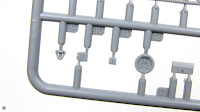AMR 35 ZT1a

“September 1939” kit series continues to explore French themes. After a batch of Renault R-35 and Hotchkis H-35 tanks and its variants, now comes something considerably more niche – AMR 35 ZT1a light reconnaissance tank in 1:72 scale. Let's take a closer look.
The box
The characteristic colourful box with a pretty nice boxart on the front bears the catalogue number PL1939-97 – yes, this is already the ninety-seventh kit released by First To Fight.
Inside one find three injection moulded sprues with grey plastic parts and a small sheet of decals.
The usual A4 booklet is also included, of course – but I will, as usual, ignore it.
Sprues
Plastic parts of the model are, as usual with this series, a mixture of nice details and “wargaming” simplifications. The upper part of the hull, for example, looks pretty good.
At the front, it is supplemented by ventilation shutters and a driver's hatch.
Storage box and another portion of shutters were provided for the rear.
The whole thing is accompanied by a number of equipment details, prepared as separate parts.
But I would like to draw particular attention to the Renault company badge reproduced on the front. Not bad.
The use of slide moulds allowed surface details such as rivets to be placed on the sides as well. This applies to both the upper parts of the hull and the otherwise quite good tub.
As usual, the simplified tracks and wheels are the weakest parts of the kit, but that's just the series' charm.
All components of the turret can be found on a separate sprue marked “E”.
The main piece, also “riveted” on the sides, is completed by a front armour plate with gun port, handles and a separately designed hatch. As well as a rotating base, of course.
Then there is the armament, mounted both inside and outside the turret.
But be aware – there is no interior in the kit. If you want to make the turret hatch open, you’ll need to deal with it by yourself.
Decals
Plastic sprues are accompanied by a small decal sheet with markings for three French vehicles.
As usual, only one of them (with turret number “26” – the boxart one) is depicted on the colour profiles. The layout of the markings on the other two vehicles is something you have to deduce for yourself.
Assembly manual
There is no typical instruction manual in the kit. Instead, a brief substitute is provided on the back of the box. The same drawings in a much larger format can also be found in the accompanying broshure.
The same is true for the colour illustrations depicting one of the French vehicles that can be made from the kit. Only Vallejo and Hataka paint numbers are suggested, and even then only some of them. A comparison with the colour profiles clearly shows that something is missing here.
Summary
Another issue of the "September 1939" series comes as absolutely no surprise. A mixture of really nice details and definitely less nice simplifications of the tracks and wheels.
However, if the latter don't bother you, the whole thing looks quite encouraging. All the more so because the subject matter is quite unusual and interesting.























